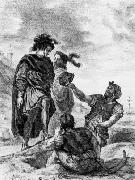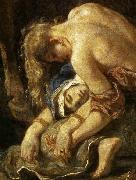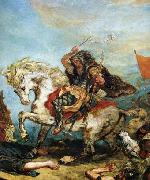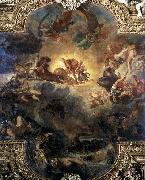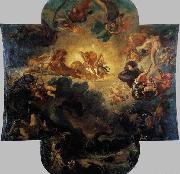
|
Artists
Index
|
||
|
Eugene Delacroix
|
||
|
Hamlet and Horatio in the Graveyard new21/Eugene Delacroix-896653.jpg ID de tableau:: 62528 |
283 x 214 mm Biblioth?que Nationale, Paris Delacroix discovered Shakespeare in 1825 on a trip to London, where the celebrated Edmund Kean was playing Richard III. In Paris, the equally famous Talma - whose town house was decorated by Delacroix - did much to popularise Shakespeare's work in French. Delacroix saw Hamlet in Paris, in the company of Hugo, de Vigny, Dumas, Nerval and Berlioz. The Shakespearean hero, imperfect, immoderate and immature, was perfectly adapted to Delacroix's temperament, and gave free rein to his imagination; in his hands, the hero could be completed and perfected. It was, of course, Hamlet who most fascinated Delacroix. "Alas, poor Yorick! - I knew him, Horatio: a fellow of most infinite jest..." (Act V, Scene 1). The scene of Hamlet and Horatio in the Graveyard inspired a painting and a series of lithographs which mirror the development of his art as a whole. Author: DELACROIX, Eug?ne Title: Hamlet and Horatio in the Graveyard Form: graphics , 1801-1850 , French , other | |
| |
|
|
|
|
||
|
The Entry of the Crusaders into Constantinople new21/Eugene Delacroix-965869.jpg ID de tableau:: 62855 |
1840 Oil on canvas Musee du Louvre, Paris Artist: DELACROIX, Eugene Title: The Entry of the Crusaders into Constantinople (detail) , painting Date: 1801-1850 French : historical | |
| |
|
|
|
|
||
|
Attila and his Hordes Overrun Italy and the Arts new21/Eugene Delacroix-872368.jpg ID de tableau:: 62857 |
1843-47 Oil and virgin wax on plaster Bibliotheque, Palais Bourbon, Paris Delacroix decorated the walls of the library of the Palais Bourbon: two great semidomes eleven metres by eight situated on either side of the room. Delacroix decided to decorate them with allegorical subjects, one representing barbarity, Attila and His Hordes Overrun Italy and the Arts, and the other civilisation: Orpheus Civilizes the Greeks. There were in addition five little domes or bays, which would present the divisions adopted in all libraries, while not following the classification too exactly: Sciences, Philosophy, Legislation, Theology and Poetry. By making such a striking contrast between his two allegorical subjects, Delacroix contrived to symbolise War and Peace, the two poles of human conduct. Artist: DELACROIX, Eugene Title: Attila and his Hordes Overrun Italy and the Arts (detail) , painting Date: 1801-1850 French : historical | |
| |
|
|
|
|
||
|
Apollo Slays Python new21/Eugene Delacroix-976299.jpg ID de tableau:: 62858 |
1850-51 Oil on mounted canvas, 800 x 750 cm Musee du Louvre, Paris This painting decorates the ceiling of the Galerie d'Apollon in the Louvre. Delacroix's greatest virtuosity was reserved for a project which came in 1850, between the decoration of the Senate and Palais Bourbon libraries and the monumental Salon de la Paix at the Hotel de Ville, and was the most important commission of Delacroix's life. It was nothing less than the decoration of the Galerie d'Apollon in the Louvre. Following a fire, Le Vau had reconstructed this historical gallery for Louis XIV, while the decoration was entrusted to Charles Le Brun. Then in 1678, Louis left Paris for Versailles, and work ceased. In 1793, in the wake of the French Revolution, the Louvre became a museum, and the Second Republic deemed the completion of the decoration a republican duty. Le Brun had intended a subject dear to the heart of the Sun King: Apollo on his chariot. For Delacroix, to make his mark at the very heart of the Louvre and to do so not by exhibiting paintings but by decorating the central part of a ceiling was a thrilling opportunity. Before he began, he felt the need to study the works of Rubens in Belgium. In his Apollo Slays Python, Delacroix retained Le Brun's ambition to portray the mythological figure of Apollo in the gallery of that name. But Delacroix enhanced Le Brun's allegory with a further allegory close to his own heart: intelligence wrestling with barbarity and light struggling with darkness. By emphasising the contrast between the two parts of his composition, the world of the sun above and that of darkness beneath, Delacroix transformed Le Brun's project and raised it to the plane of an eternal symbol. The subject, which Delacroix took from Ovid's Metamorphoses, is effectively the victory of Good over Evil. But it takes the form of beauty vanquishing the ugly and genius dispelling stupidity. Artist: DELACROIX, Eugene Title: Apollo Slays Python , painting Date: 1801-1850 French : mythological | |
| |
|
|
|
|
||
|
Apollo Vanquishing the Python new21/Eugene Delacroix-989245.jpg ID de tableau:: 62859 |
1850-51 Mural painting, about 800 x 750 cm Musee du Louvre, Paris This is the central panel of the vaulted ceiling of the Galerie d'Apollon in the Louvre. One of Delacroix's lesser-known masterpieces, the subject-matter was dictated by its destination. Apollo Vanquishing the Python shows the painter working in a direct line from the great decorators of the seventeenth and eighteenth centuries, without losing any of his own ardor or lyricism. Artist: DELACROIX, Eugene Title: Apollo Vanquishing the Python , painting Date: 1801-1850 French : mythological | |
| |
|
|
|
|
||
| Artiste précédent Artiste prochain | ||
|
Also Buy::. For Following Paintings / Artists / Products, Please Use Our Search Online: |





